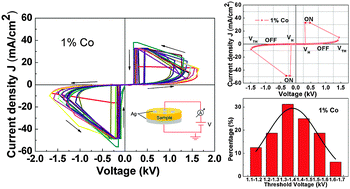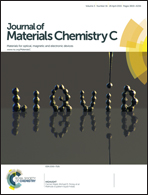Room temperature threshold switching behaviors of Bi0.9Nd0.1Fe1−xCoxO3 nanoparticles
Abstract
Many investigations have reported threshold switching (TS) effects in amorphous semiconductors, but it is rarely observed in BiFeO3 nanoparticles. Here, the effects of cobalt doping on the electrical conductivity of Bi0.9Nd0.1Fe1−xCoxO3 (x = 0, 0.01, 0.03, 0.05) nanoparticles were investigated. Leakage current density (J) versus applied voltage (V) curves were measured and it was found that the leakage current increases with increases of the cobalt dopant concentration. With the increase of the maximal applied voltage, the samples with cobalt doping exhibit nearly symmetric TS behaviors at room temperature. With the increase of cobalt dopant concentration, the optical band gap is decreased, and the smallest optical band gap value (∼2.01 eV) is observed for the 3% Co doped BiFeO3 sample. X-ray photoelectron spectroscopy of the samples shows that the cobalt dopant induces an enhancement of the oxygen vacancy concentration. Possible mechanisms for the threshold switching effects are discussed on the basis of a conductive filament model. The mobile charge carriers align to form conducting filaments when the threshold voltage (VTH) is achieved, corresponding to the transition from a high-resistance state to a low-resistance state, and the rupture of the conductive path takes place when the applied voltage is decreased. The leakage current decreases dramatically and eventually returns to the initial high-resistance state.


 Please wait while we load your content...
Please wait while we load your content...